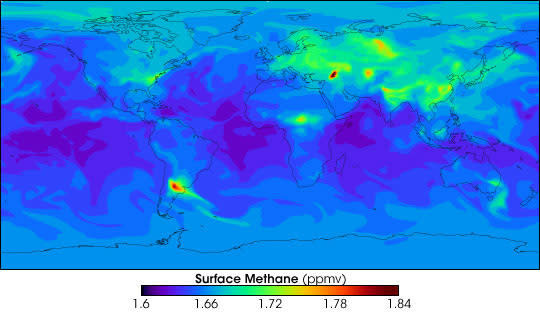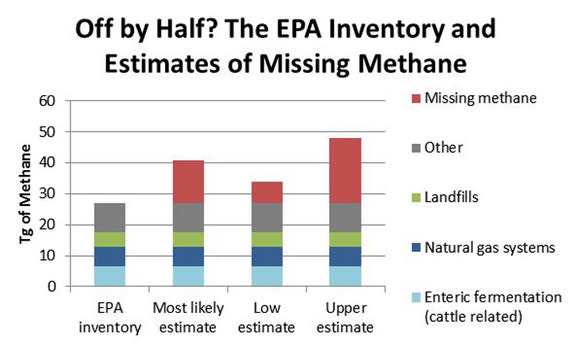The Mystery of the Missing Methane (Op-Ed)
Chris Busch is director of research at Energy Innovation: Policy and Technology. He contributed this article to Live Science's Expert Voices: Op-Ed & Insights.
A new landmark study in the journal Science found that the U.S. Environmental Protection Agency's (EPA) inventory of greenhouse gases is undercounting total U.S. methane emissions by roughly 50 percent. Based on atmospheric sampling, the study estimates that this missing methane amounts to 14 terra grams (Tg) of methane; that's equal to 6.4 billion pounds, or as much as the weight of 1.4 million new Ford F150 pickup trucks.
In the years immediately after it's released, methane is a potent greenhouse gas. It causes 86 times as much global warming over a 20-year period as carbon dioxide, the single largest contributor to climate change. According to our analysis at Energy Innovation, the methane missing from the EPA's inventory — in terms of the contribution to global warming over a 20-year time period — would be equivalent to the greenhouse gas emissions of 252 coal power plants.
At the same time that the scientific community is finding evidence that methane is being undercounted, the newly released draft version of the U.S. EPA's national greenhouse-gas emission inventory presents data showing that methane emissions from natural gas are falling. The new draft inventory releases 2012 data for the first time, and claims that emissions from methane fell by roughly 2 percent compared to 2011. The new draft inventory also revised downward estimates for past years because of new information about reduced emission well completions (the process that gets natural gas to start flowing) and other voluntary mitigation steps received from companies.
This treatment of methane emissions from natural gas is difficult to reconcile with the new Science study by Adam Brandt of Stanford University and his colleagues, the most comprehensive analysis of both "top-down" and "bottom-up" methane-emission studies ever.
Top down studies take air samples from aircraft or towers. These types of studies offer an accurate measurement of overall methane emissions, but they are not as well suited to attributing emissions to particular sources compared to bottom-up methods, which measure emissions directly at the source. The estimates of missing methane are based on direct sampling of the atmosphere, whereas the EPA inventory involves many assumptions and depends upon accurate self-reporting of voluntary emission reduction efforts by the extraction companies.
The EPA greenhouse gas inventory uses data from "bottom up" studies to develop emission factors for different components of the entire natural gas system from production (extraction from the ground), to processing, transmission and distribution. These emission factors are part of an attempt to calculate representative quantities of pollution released with each of the activities that make up the natural gas system. Roughly speaking, there is an emission factor for conventional-well completions and a lower one for reduced-emission-well completions that use pollution controls. The emission factor is multiplied by the number of well completions of each type to estimate their contribution to total emissions from the natural gas system.
A limitation of the bottom-up studies upon which the EPA inventory relies is a requirement that researchers obtain access to natural-gas operations. It has been challenging for researchers to secure permission to do that type of work. As a result, bottom up studies struggle to attain large sample sizes that would give confidence that they are broadly representative of the whole industry. There is also a concern that the companies that volunteer to be measured are likely to be the most responsible operators, i.e. lower emitting. Evidence is accumulating that a small number of leaks are responsible for a large fraction of methane emissions, and these outlier emissions are most likely emanating from the less-responsible producers.
The EPA should take a more active role in generating the comprehensive data needed to improve the inventory's estimate of methane emissions. The draft inventory states that, "the EPA will continue to refine the emission estimates to reflect the most robust information available." This is too passive an approach.
Emerging detection and measurement technologies offer hope for greater accuracy in measuring and understanding methane leakage. Infrared cameras that can locate leaks are required under a recently approved Colorado regulation. Car-mounted devices sample the air and can locate leaks and estimate their magnitude from a distance, which avoids the challenge of acquiring property owner permission that bedevils direct on-site measurement. Engineers are also developing low-cost stationary detectors .
The current oil and gas boom has been unleashed by a wave of technological innovation allowing for cost-effective directional drilling, hydraulic fracturing and other emerging techniques, like "acidizing." Governments need to keep pace with faster innovation on the regulatory side. The EPA should quickly embrace new monitoring technologies to improve the accuracy of government emissions monitoring, which will both aid in the enforcement of clean air rules and limit methane's contribution to climate change.
The authors' most recent Op-Ed was "States Take National Lead in Regulating Fracking." The views expressed are those of the author and do not necessarily reflect the views of the publisher. This version of the article was originally published on Live Science.
EPA's New Car Emissions Standards Will Clear the Air (Op-Ed)
Urbanization Can Actually Reduce Greenhouse Gas Emissions (Op-Ed)
Copyright 2014 LiveScience, a TechMediaNetwork company. All rights reserved. This material may not be published, broadcast, rewritten or redistributed.



